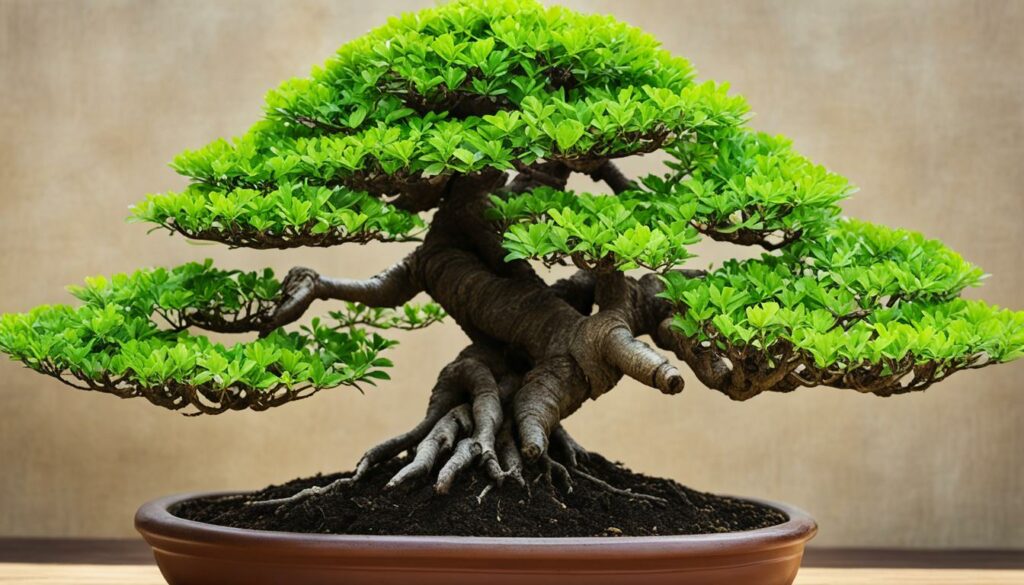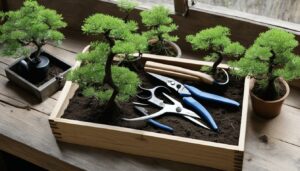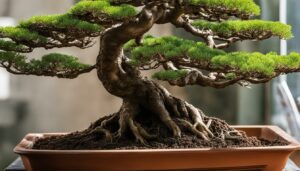As an enthusiast in the delicate art of bonsai care, you understand that achieving robust bonsai growth hinges on more than just meticulous pruning and styling. Feeding bonsai with the right nutrients is paramount to cultivating a miniature masterpiece. But with a myriad of fertilizer options and methods, how can you ensure you’re providing the best possible care for your treasured tree?
Mastering bonsai fertilizing is not simply a matter of scattering some feed and hoping for the best. It requires a tailored approach that considers the unique needs of your bonsai. Whether you’re nurturing an ancient pine or a blossoming cherry, grasp the essentials of bonsai fertilization to ensure that your bonsai thrives with vitality and beauty.
Key Takeaways
- Grasp the importance of bespoke fertilization to cater to your bonsai’s specific dietary needs.
- Learn to discern the right fertilizer type to promote a verdant and vigorous growth.
- Discover the pivotal role of both macronutrients and micronutrients in achieving optimal bonsai health.
- Understand the risks and consequences of under-fertilizing or over-fertilizing your bonsai.
- Gain insights into the signs of nutritional imbalances and how to rectify them.
- Familiarize yourself with the science that informs smart feeding practices for your bonsai.
Understanding the Importance of Bonsai Nutrition
Proper bonsai nutrition is a cornerstone for achieving a thriving miniature landscape. Beyond aesthetic appeal, efficient nutrition fosters the essential physiological functions of your bonsai, influencing everything from vibrant leaf development to robust root strength. Ignoring these critical requirements can impair bonsai growth and overall health.
Imbalanced feeding, whether it be through under-fertilizing or over-fertilizing, can have detrimental consequences for your bonsai’s wellbeing. Under-fertilizing might lead to a bonsai that struggles to flourish, with weak foliage and underdeveloped roots. Over-fertilizing, on the other hand, may overwhelm the bonsai, leading to nutrient burn and compromised immunity.
Creating a balanced dietary plan for your bonsai involves understanding the unique demands of your tree. This includes recognizing the proper nutrients required at various growth stages and adjusting your care regimen accordingly. Reflect on the needs of your bonsai and your approach to bonsai care with the following comparison:
| Scenario | Impact on Bonsai Nutrition | Recommended Action |
|---|---|---|
| Under-Fertilizing | Limited foliage growth, weak structure | Increase feeding frequency; reassess nutrient balance |
| Over-Fertilizing | Nutrient burn, susceptibility to disease | Reduce fertilizer amount; provide ample water to dilute |
| Imbalanced Nutrients | Poor leaf color, stunted development | Analyze soil and adjust fertilizer composition |
Bonsai trees are unique in their presentation and needs, each one requiring a personalized touch to reach its potential. By dedicating time to comprehend bonsai care intricacies, including the nuances of bonsai nutrition, you’re laying the foundation for your bonsai to flourish for years to come.
Decoding Bonsai Fertilizer Types
When cultivating bonsai, selecting the right fertilizer is a crucial decision that impacts not only the vitality of your miniature trees but also the environment. Fertilizer types range broadly, each with their own mechanism of action and spectrum of benefits. Whether you are leaning towards the use of organic fertilizers for a more natural approach or considering chemical fertilizers for their precise nutrient compositions, understanding the differences is essential for effective feeding of your bonsai.
Chemical vs. Organic Fertilizers
Chemical fertilizers are formulated to provide an immediate supply of nutrients to your bonsai, and they’re often preferred for their consistency and predictable results. These inorganic options, however, can sometimes lead to salt build-up in the soil, which might harm the fine roots of your bonsai. Conversely, organic fertilizers, derived from natural sources, offer a gentler, slower-release feeding option that enhances soil health over time and reduces the risk of over-fertilization.
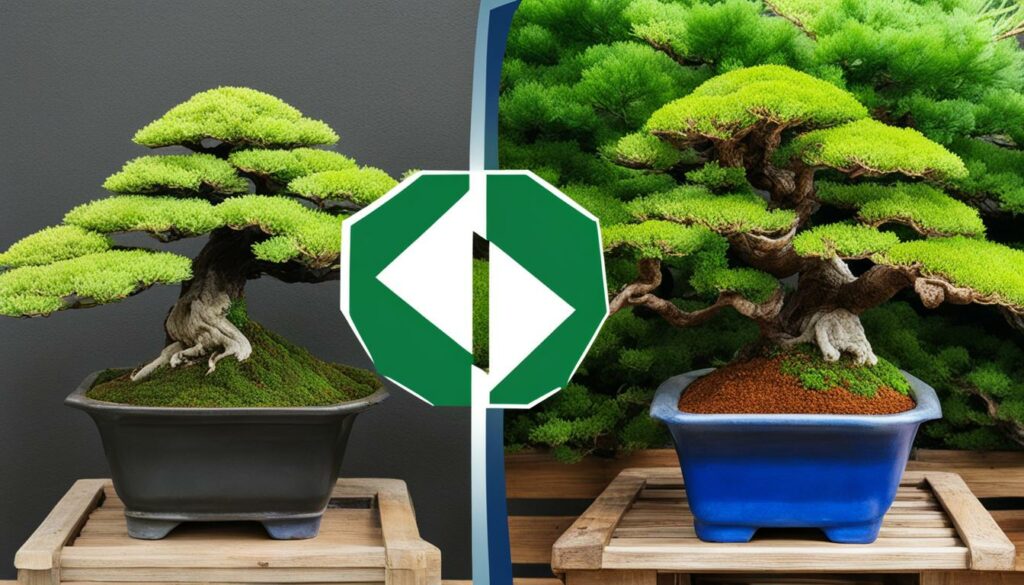
Liquid, Granular, and Slow-Release Options
The method by which fertilizers are applied can equally influence their effectiveness. Liquid fertilizers ensure quick nutrient uptake but require frequent application, making them labor-intensive. Granular types are easier to apply but can be less uniform in distribution. Slow-release fertilizers are increasingly popular for their convenience; they gradually supply nutrients over time, requiring less frequent application and thereby providing a sustained feed that can be ideal for the consistent growth patterns desirable for bonsai.
Choosing between these fertilizer types for feeding bonsai is not just about preference but also about understanding the specific needs of your bonsai and the environment you are creating for it. Your approach to bonsai care should encompass a well-balanced fertilization strategy that promotes robust growth while preserving the delicate eco-balance of these unique miniature ecosystems.
The Role of Macronutrients in Bonsai Health
As you delve into the world of bonsai care, understanding the pivotal role of macronutrients—namely nitrogen (N), phosphorus (P), and potassium (K)—becomes essential. These elements are the building blocks of a robust bonsai, ensuring it thrives and displays its majestic beauty. Let’s explore each macronutrient’s unique contributions to bonsai fertilizing and pinpoint the telltale signs when your bonsai may be craving or getting too much of these nutrients.
- Nitrogen (N) is paramount for foliage growth, giving your bonsai those lush, vibrant leaves. A nitrogen deficiency often leads to stunted growth and yellowing leaves, while excess can cause overgrowth and weak, leggy plants.
- Phosphorus (P) is crucial for root development and flowering. When phosphorus is lacking, you might notice a slow growth rate and dull, darkened foliage. An excess isn’t common, but it can lead to nutrient lockout, where your bonsai is unable to absorb other essential elements.
- Potassium (K), the third key player in the macronutrient trio, aids in overall plant health, disease resistance, and water regulation. Signs of potassium deficiency include browning at the edges of leaves and a general weakening of the plant structure.
Regular application of a balanced fertilizer is a vital aspect of bonsai care, playing a significant role in preventing nutrient imbalances. To guide your bonsai fertilizing routine, here’s a handy reference table for the roles of each macronutrient and the visual cues that your bonsai might present in relation to their levels:
| Macronutrient | Primary Role | Deficiency Signs | Excess Signs |
|---|---|---|---|
| Nitrogen (N) | Leaf and stem growth | Yellowing leaves, weak growth | Rapid, soft, and dark green foliage; weak stems |
| Phosphorus (P) | Root and flower development | Stunted growth, darkened leaves | Nutrient lockout, preventing uptake of other elements |
| Potassium (K) | Plant vigor and disease resistance | Browning leaf edges, wilting | Rare, but can cause overall nutrient imbalances |
Incorporating knowledge of macronutrients into your bonsai fertilizing practices is not just about adding supplements to the soil; it’s a form of artful attention that echoes across every aspect of your bonsai’s life, from the daintiest leaf to the deepest root.
Essential Micronutrients for Optimal Growth
When we speak of bonsai nutrition, the focus often lands on the well-known macronutrients: nitrogen, phosphorus, and potassium. However, micronutrients play an equally vital role in keeping your bonsai healthy and promoting vigorous bonsai growth. Though required in smaller quantities, elements like calcium, magnesium, and iron are the unsung heroes that contribute to a myriad of functions within your bonsai’s physiology, from enzyme production to chlorophyll synthesis.
Meticulously curating your bonsai’s diet to include these micronutrients is not just an advanced care technique; it’s a fundamental aspect of bonsai care that can mean the difference between a surviving tree and a thriving one. Let’s delve into the unique roles that each of these essential micronutrients plays in the life of a bonsai:
- Calcium: Beyond its role in human bone health, calcium serves as a pivotal player in cell wall construction and root development in plants.
- Magnesium: This is the central atom in the chlorophyll molecule, making it critical for photosynthesis and giving the bonsai leaves their lush green hue.
- Iron: Vital for chlorophyll production, iron also functions in several enzyme systems and is crucial for energy transfer within the plant.
Recognizing a deficiency in any of these micronutrients is your first step to correcting imbalances and ensuring your bonsai remains resplendent and robust. Take note of the signs:
| Micronutrient | Deficiency Signs | Impact on Bonsai Growth |
|---|---|---|
| Calcium | Young leaves may appear distorted or irregularly shaped. | Inhibited root and shoot development, leading to stunted growth. |
| Magnesium | Leaves turn yellow between the veins, mainly on older leaves. | Reduction in photosynthesis can diminish the overall health and vigor. |
| Iron | Youngest leaves exhibit chlorosis (yellowing), starting at the tips. | Severely limits chlorophyll production affecting energy transfer and growth. |
If you observe any of these symptoms, it’s crucial to conduct a soil test or consult with a bonsai expert to address the deficiency responsibly. Remember that balance is key; overcompensation can be just as detrimental as the shortage itself.
Ensuring a comprehensive supply of both macro and micronutrients can unlock the full potential of your bonsai, creating not just a miniature tree, but a miniature masterpiece. By paying attention to the subtle cues of micronutrient needs, you can enjoy the art of bonsai with the confidence that your green companion is enjoying full-bodied bonsai nutrition for stellar growth.
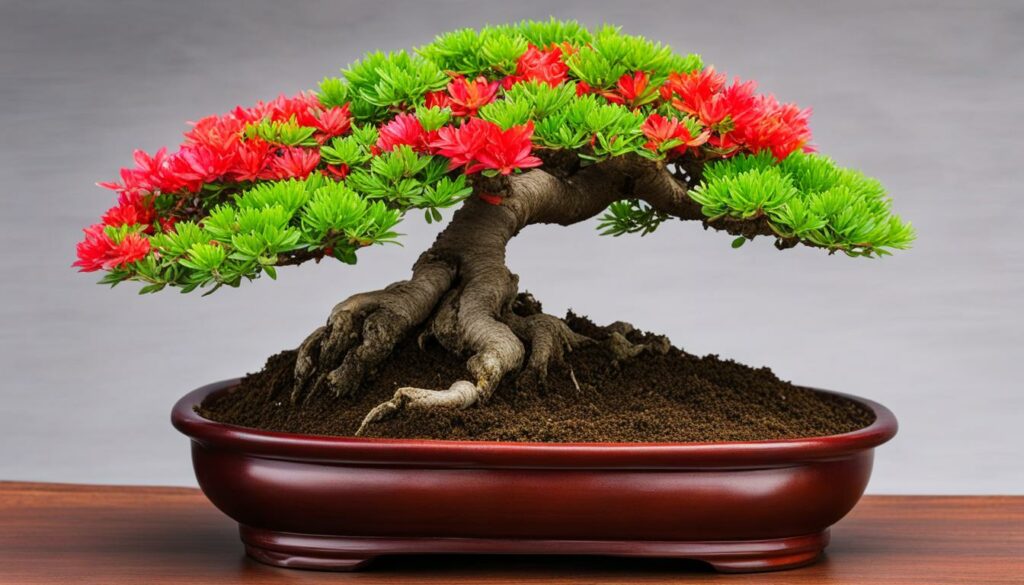
The Science of Bonsai Fertilizing
Understanding bonsai nutrition is not just about applying fertilizers; it’s about comprehending the scientific relationship between the soil, the nutrients, and your bonsai’s biology. We’ll delve into the chemistry of the soil and the physiological processes of your bonsai to ensure you are feeding bonsai in the most effective way.
Bonsai trees, like all living organisms, require a precise balance of nutrients to thrive. When we talk about bonsai fertilizing, we’re addressing the ways these nutrients are absorbed through the fine network of roots beneath the soil. A bonsai’s root system takes in nutrients during watering, which then are transmitted to support growth and cellular function throughout the tree. However, the nutrient uptake is highly dependent on the soil’s pH level – the measure of acidity or alkalinity.
To optimize the health of your bonsai, it’s important to maintain a soil pH that falls within a range conducive to nutrient absorption. With an imbalanced pH level, your bonsai may struggle to access essential nutrients, even if they are abundant in the soil. Achieving the correct pH balance not only augments nutrient uptake but also prevents harmful metal ions from becoming soluble and toxic to your bonsai.
Here’s a simple guide on the interaction between soil chemistry and bonsai health:
| pH Level | Nutrient Availability | Effect on Bonsai Health |
|---|---|---|
| Low (Acidic) | Increased availability of micronutrients | Potential toxicity from excessive metals |
| Ideal | Balanced availability of macro and micronutrients | Optimal growth and development |
| High (Alkaline) | Decreased availability of micronutrients | Possible deficiencies leading to poor health |
Maintaining an ideal soil pH level is essential for effective bonsai fertilizing, allowing your miniature tree to tap into its full potential. Remember—a healthy bonsai is a result of deliberate and scientific nurturing that goes beyond simple care practices, integrating a deep understanding of bonsai biology and chemistry.
Assessing Your Bonsai’s Fertilizer Needs
When it comes to bonsai care, understanding the individual needs of your bonsai species is critical. Each variety of bonsai has a unique set of characteristics and requirements. Knowledge of these can help you in feeding bonsai the right way and make sure that your bonsai thrives. Let’s delve into how to tailor your approach based on the type of bonsai you’re nurturing and the environmental factors it experiences.
Considering Bonsai Species
Whether you’re tending to a Juniper, a Ficus, or a Pine, the species of your bonsai plays a pivotal role in determining its fertilizer needs. For example, tropical bonsai species often have a continual growing season and may require consistent fertilization, while temperate species have a dormancy period that requires a change in feeding routines. To guide you, here is a comparison of different bonsai species and their preferred fertilizer compositions:
| Bonsai Species | Nitrogen | Phosphorus | Potassium |
|---|---|---|---|
| Juniper Bonsai | Low | Medium | High |
| Ficus Bonsai | High | Medium | Medium |
| Pine Bonsai | Medium | High | Low |
Sunlight and Watering Impact
Just as important as the bonsai species are the environmental conditions like sunlight and watering received, which heavily influence your bonsai’s fertilizer needs. A bonsai that gets ample sunlight may require more frequent fertilization due to increased photosynthesis and growth, while one in modest light will need less. Similarly, your watering habits can affect nutrient uptake, with overwatered plants becoming prone to nutrient deficiencies. It’s all about balance and observation, adjusting your feeding routine to the signs your bonsai gives you.
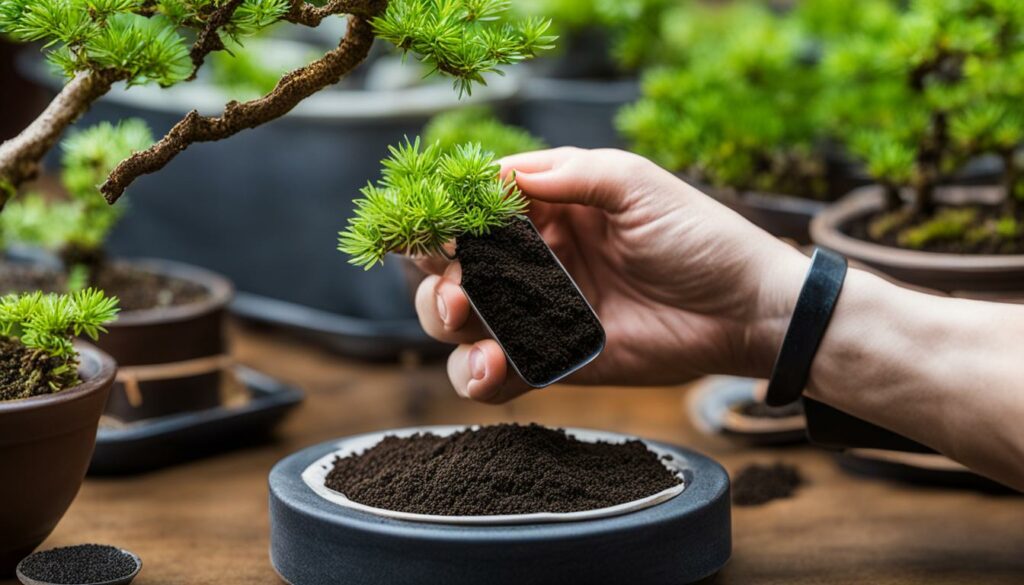
Remember to consider how your bonsai’s exposure to elements might tailor its diet. Keep a close watch on how your bonsai responds after you’ve adjusted sunlight levels and water frequency, and fine-tune your feeding regimen accordingly. With a careful eye and an understanding of your bonsai’s specific needs, you will ensure that your miniature tree stays healthy and continues to bring joy for years to come.
Best Practices for Feeding Bonsai
Fostering a vibrant bonsai involves nuanced care and attentiveness, especially when it comes to feeding. To ensure your bonsai thrives, it’s imperative to master the art of seasonal fertilization and understand the ideal frequency and amount required for optimal growth. Let’s delve into the key tactics that will elevate your bonsai’s health and appearance.
Seasonal Fertilization Techniques
As the seasons change, so too should your approach to feeding bonsai. During the spring, your bonsai enters a period of active growth and will benefit most from a balanced fertilizer that promotes robust foliage and root development. Summer requires a continued, yet cautious nourishment, as excessive heat can stress the tree. In fall, a low-nitrogen mix prepares the bonsai for dormancy, supporting root health without encouraging new shoots that won’t withstand winter chill. Finally, winter is a time for rest, and fertilization should be minimal or withheld until the onset of spring.
Fertilization Frequency and Amount
Determining the right frequency and volume of fertilizer is critical for preventing nutrient burn or deficiency. As a rule of thumb, feeding bonsai should occur during the growing season but the rate can vary based on the type, age, and health of the plant. Younger trees generally require more frequent feeding compared to older, established bonsai. Meanwhile, the actual quantity of fertilizer depends on the product’s strength and the size of your bonsai.
| Season | Frequency | Type of Fertilizer | Amount |
|---|---|---|---|
| Spring | Every two weeks | Balanced NPK | According to label |
| Summer | Every two to four weeks | Balanced NPK, lower nitrogen in hot months | Half-strength during peak heat |
| Fall | Monthly | Low-nitrogen, higher phosphorus and potassium | According to label, adjusted for cooler temperatures |
| Winter | Withhold or minimal | – | – |
Remember, moderation is key in feeding bonsai; a consistent light touch is preferred over sporadic heavy doses.
Correctly Applying Fertilizer to Your Bonsai
Mastering bonsai fertilizing is integral to the success of your miniature tree’s growth and longevity. In this section, you’ll learn essential tips for feeding bonsai effectively, to avoid common errors like root burn, which can be as detrimental as neglect. Following these guidelines will help maintain ideal bonsai care and encourage vibrant health.
Before you begin, ensure you have read the instructions on your fertilizer packaging and are wearing appropriate protective gear.
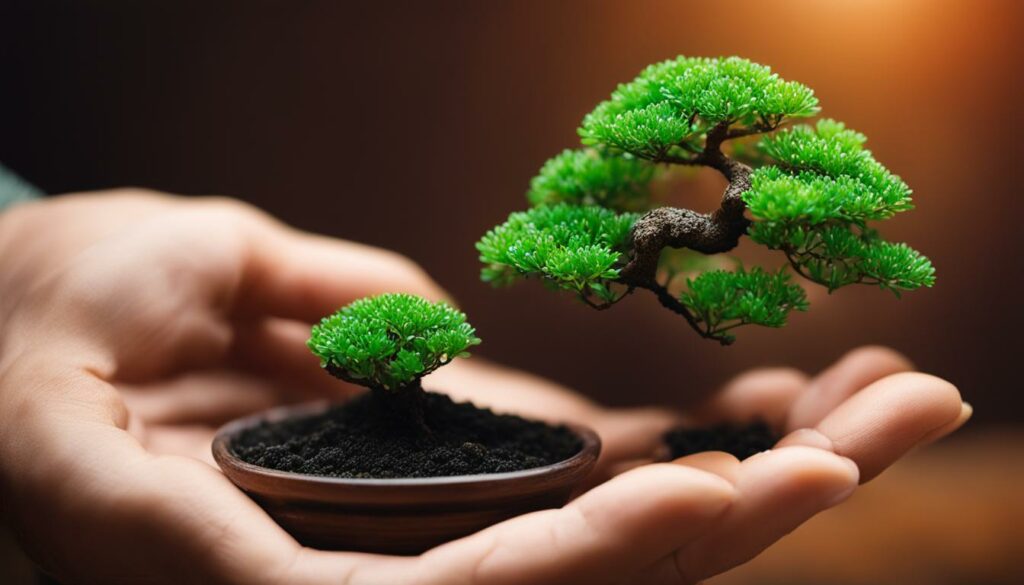
- Check the soil moisture – Your bonsai soil should be moist before applying fertilizer. Never fertilize dry soil as it can burn the roots.
- Select the right fertilizer – Choose a balanced fertilizer specifically designed for bonsais or a general-purpose one that can be diluted accordingly.
- Prepare the fertilizer – If you’re using liquid fertilizer, dilute it as directed. For granular types, measure the correct amount for your bonsai’s size.
- Apply evenly – Distribute the fertilizer evenly around the base of the plant, away from the trunk, to ensure all roots receive nutrients.
- Gentle watering – After applying granular fertilizer, gently water your bonsai to help the nutrients seep into the soil.
- Observe – Monitor your bonsai after fertilizing for any signs of stress and adjust your approach if needed on the next application.
Creating a routine is another central component of bonsai care. Sticking to a regular fertilizing schedule—usually during the growing season—supports balanced, healthy growth. Pay close attention to your bonsai’s response over time, and be prepared to adjust your fertilizing techniques as it matures and as seasons change. Properly feeding bonsai is not a one-time action but an ongoing part of your interaction with your living art form. Remember, consistent care results in a thriving bonsai that you can enjoy year-round.
Common Mistakes in Bonsai Fertilization
When it comes to the art of bonsai care, attentiveness is paramount—especially with regard to fertilization. A seemingly simple task, fertilizing can lead to a host of issues if not done correctly, impeding the desired bonsai growth and health. Let’s delve into some of the most common fertilizing mistakes you may encounter and examine ways to correct them for the well-being of your miniature green companions.
Over-fertilization does not mean more robust growth; it can cause more harm than good. Balance is the secret to thriving bonsai.
Here are the primary missteps often made:
- Excess Fertilization: More isn’t always better. Overloading your bonsai with nutrients can lead to nutrient burn, characterized by brown or curled leaf edges.
- Wrong Fertilizer Type: Utilizing generic or inappropriate fertilizers that don’t align with your bonsai’s specific requirements can disrupt its delicately balanced ecosystem.
- Improper Timing: Fertilizing at the wrong time of year can interfere with the bonsai’s natural growth cycle, potentially causing undue stress.
Recognizing these errors early can prevent lasting damage. Now, consider this comparative analysis of symptoms and remedies:
| Error | Symptoms | Remedies |
|---|---|---|
| Over-Fertilization | Yellowing leaves, stunted growth | Flush soil with water, reduce feeding frequency |
| Wrong Fertilizer | Leaf discoloration, weak root system | Research your bonsai’s needs, switch to recommended fertilizer |
| Off-Season Application | Lack of dormancy, abnormal leaf size | Schedule fertilization to align with active growth stages |
To ensure you’re nourishing your bonsai appropriately, monitor its response after each fertilization. Signs of improvement will confirm you’re on the right track, and you’ll be gratified to witness the flourishing results of your corrective actions.
Organic Fertilizer Recipes for Bonsai Enthusiasts
Tapping into the Earth’s natural bounty, you can create organic fertilizer that will enrich your bonsai and make a positive environmental impact. Homemade fertilizers not only provide a balanced feed tailored for your miniature trees but also offer a fulfilling eco-friendly gardening practice. Let’s look at composting methods and DIY natural fertilizers you can start making at home.
Composting at Home for Bonsai Use
Composting is an excellent approach to recycling kitchen and garden waste into a potent organic fertilizer for your bonsai. Rich in nutrients, compost can be used as a soil amendment to improve structure and fertility. Starting a compost pile requires a blend of green (nitrogen-rich) and brown (carbon-rich) materials, water, and air circulation to encourage decomposition.
- Green materials: vegetable scraps, coffee grounds, fresh grass clippings
- Brown materials: dried leaves, cardboard, straw
- Water: maintain moist but not soggy conditions
- Air circulation: turn your pile regularly to introduce oxygen
DIY Natural Fertilizers
Beyond composting, several kitchen and garden by-products can be turned into DIY natural fertilizers, perfectly suiting bonsai needs. These fertilizers are cost-effective and environmentally friendly, ensuring your bonsai receives all necessary nutrients without chemical additives.
| Ingredient | Nutrient Provided | Usage Instructions |
|---|---|---|
| Eggshells | Calcium | Clean and crush, sprinkle around the bonsai base |
| Banana Peels | Potassium | Chop and bury slightly in the soil or steep in water to create a liquid fertilizer |
| Fish Tank Water | Nitrogen and trace minerals | Use water from freshwater tanks during regular changes to water your bonsai |
| Coffee Grounds | Nitrogen | Mix into soil or sprinkle on top for a slow-release effect |
Remember, the key to composting and creating your DIY natural fertilizers is balance. Test and monitor your bonsai’s response to adjust the fertilizers as needed. Healthy growth, vibrant foliage, and robust roots are signs you’re on the right track with your organic approach to bonsai nutrition.
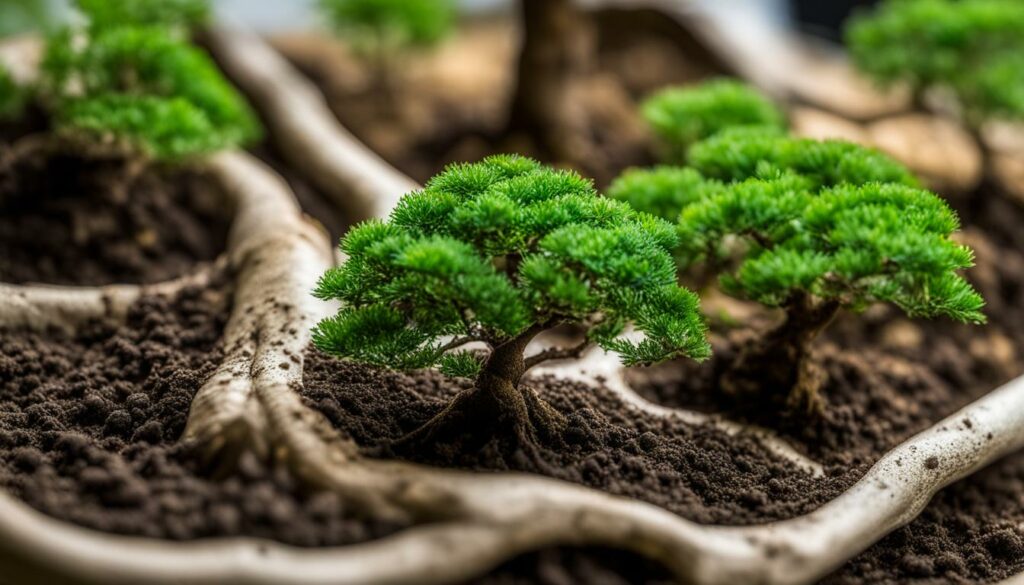
Monitoring Bonsai Growth and Response to Fertilizers
As an avid bonsai enthusiast, understanding the subtle changes in your bonsai’s appearance is essential for optimal care. Vigilant monitoring of bonsai growth patterns and the response to bonsai fertilizing regimes can provide you with insights into the health and needs of your bonsai tree. By observing leaf color, growth rate, and overall plant vigor, you can fine-tune your fertilizing strategy to ensure your bonsai receives the best care possible.
Remember, the objective is to mimic the natural growing conditions of bonsai, providing a balance of nutrients that supports both root development and foliage growth.
Indicators of effective bonsai fertilizing include a vibrant leaf color, a steady increase in new growth, and an absence of yellowing or browning leaves. Should you notice any discoloration or stunted growth, it might be time to adjust your bonsai’s nutrition.
Keep in mind that each bonsai is unique, and a fertilizing approach that works for one may not be suitable for another. It’s a process of continuous learning and adjusting based on how your bonsai reacts to care.
- Examine new foliage for size and color vigor
- Check for signs of over-fertilizing, such as salt buildup in the soil or leaf burn
- Monitor growth throughout the growing season to adjust fertilizing schedules accordingly
Your bonsai care regimen is a delicate balance that, when struck, leads to a thriving and aesthetically pleasing miniaturized tree. So pay close attention and react promptly to what your bonsai tells you—after all, it’s the best communicator of its own health.
Troubleshooting: When Bonsai Fertilizing Goes Wrong
Effective bonsai care extends beyond the routine watering and placement in the right lighting; feeding bonsai correctly is vital for its overall well-being. As nurturing as fertilization can be, it can also lead to a host of problems if not executed properly. If you’re facing issues like leaf drop, discoloration, or stunted growth, it’s time to examine your fertilization methods. These are telltale signs that your bonsai is unhappy with its nutritional state, and prompt action is required to amend any potential damage.
To rectify fertilizing problems, begin by assessing your fertilization schedule and the products you’re using. Overfeeding can be just as harmful as underfeeding, causing nutrient burn or imbalances that inhibit growth. Conversely, signs of underfeeding can be subtle but detrimental in the long term. Start troubleshooting by flushing the soil with water if over-fertilization is suspected to remove excess nutrients. Then, ensure the adoption of a more tailored approach to your bonsai’s specific needs, considering the species, the current season, and the tree’s life stage.
Your bonsai’s reaction to corrective measures will not be immediate, and patience is necessary during this period of rehabilitation. Continuously monitor the plant’s response over the following weeks, looking for improvement in leaf color and vitality. Adjust your fertilizing methodology accordingly, seeking a balance that promotes growth without overwhelming your delicate bonsai. With attentive care and adjustment, your bonsai can recover and flourish, showcasing the resilience and beauty that make bonsai cultivation so rewarding.
FAQ
Why is fertilizing my bonsai important?
Fertilizing your bonsai is crucial for supplying the necessary nutrients that support robust growth, leaf development, and root strength. It ensures your bonsai stays healthy and displays its beauty to the fullest.
How does bonsai nutrition impact the health of my tree?
Proper bonsai nutrition affects all physiological functions of your tree, from budding to the strength of the trunk and roots. A balanced diet helps prevent diseases and supports the overall vitality of your bonsai.
What are the differences between chemical and organic fertilizers?
Chemical fertilizers are synthetically produced and can provide nutrients quickly. Organic fertilizers come from natural sources and release nutrients slower, improving soil structure and microbial life. Each type has its benefits and appropriate applications.
How do I choose between liquid, granular, and slow-release bonsai fertilizers?
Your choice depends on your bonsai’s needs, your watering practices, and your personal preference. Liquid fertilizers are fast-acting, granular provide a steady supply of nutrients, and slow-release pellets are convenient for extended nourishment.
What roles do macronutrients play in bonsai health?
Macronutrients like nitrogen, phosphorus, and potassium are essential for various functions. Nitrogen promotes leaf growth, phosphorus supports root development, and potassium enhances overall health and disease resistance in bonsai trees.
Why are micronutrients important for my bonsai?
Micronutrients, including calcium, magnesium, and iron, are critical for various internal processes. They support photosynthesis, enzyme function, and overall plant metabolism, contributing to a balanced growth of your bonsai.
How does soil pH impact bonsai fertilizing?
Soil pH can significantly affect how your bonsai absorbs nutrients. An incorrect pH balance can lead to nutrient deficiencies or toxicities, so it’s important to maintain the right pH level for optimal nutrient uptake.
How do I assess my bonsai’s fertilizer needs?
Look at factors like the bonsai’s species, which influences its nutrient requirements, as well as its current health, growth stage, and environmental conditions like sunlight and watering frequency.
What are the best practices for seasonal bonsai fertilization?
Seasonal bonsai fertilization practices involve adjusting the type, frequency, and amount of fertilizer you apply to match your bonsai’s growth cycles and dormancy periods, as these needs change throughout the year.
How should I correctly apply fertilizer to my bonsai?
Apply fertilizer evenly to moist soil, avoiding direct contact with the trunk. Use the appropriate amount, and consider the specific needs of your bonsai to prevent over-fertilizing and potential root burn.
What are some common fertilization mistakes that I should avoid?
Common mistakes include over-fertilizing, using an incorrect type of fertilizer, and fertilizing at inappropriate times. It’s essential to follow a tailored fertilization plan to prevent these errors.
Can I make my own organic fertilizer for my bonsai?
Yes, you can create homemade organic fertilizers using compost or natural ingredients like seaweed, fish emulsion, or bone meal. These can be healthier options for your bonsai and the environment.
How can I tell if my bonsai is responding well to the fertilizers?
Look for signs like stable growth, vibrant leaf color, and an overall appearance of vitality. Lack of progress or negative changes may indicate issues with the fertilization regimen.
What should I do if I suspect a problem with my bonsai fertilizing approach?
Diagnose the issue by checking for symptoms like leaf drop, yellowing, or stunted growth. Adjust your fertilization practices based on your findings and seek expert advice if necessary.
